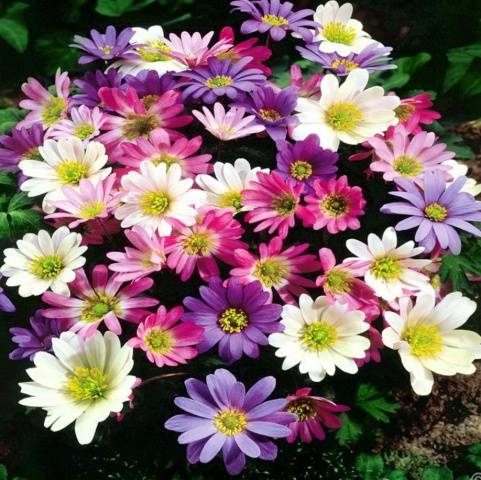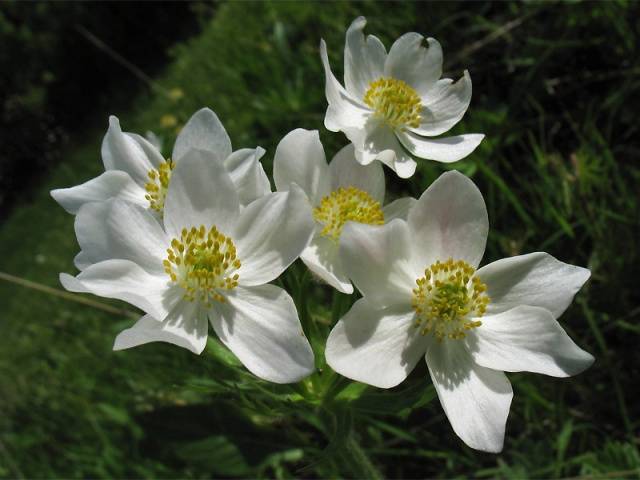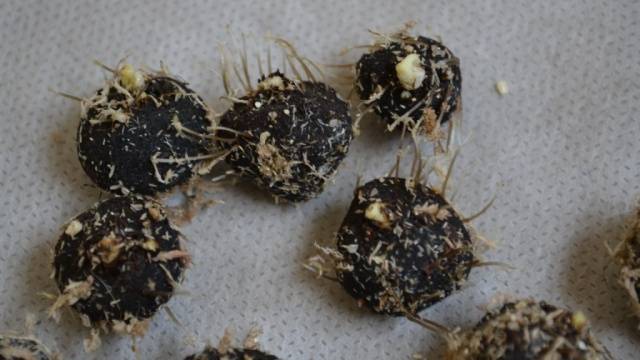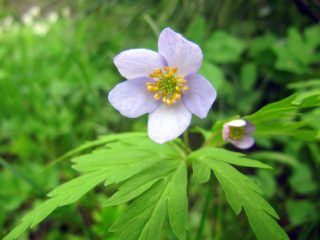Content
Anemone or anemone is a perennial plant from the Ranunculaceae family. The genus consists of approximately 150 species and is widely distributed under natural conditions throughout the Northern Hemisphere, except in the tropics. Anemones mainly grow in the temperate zone, but some of the most beautiful ones came to us from the Mediterranean. Nine species live beyond the Arctic Circle, and 50 live in the countries of the former Soviet Union.
The name "anemone" is translated from Greek as "daughter of the wind." The flower is revered in many countries; many legends surround it. It is believed that it was anemones that grew at the site of the crucifixion of Jesus Christ, right under the cross. Esotericists claim that the anemone symbolizes sadness and the transience of life.
This is a very beautiful flower, and thanks to its diversity of species, it can satisfy every taste. Plants differ greatly in appearance and requirements for growing conditions. Early spring anemones are completely different from those blooming in autumn.
General description of anemone
Anemones are herbaceous perennials with a fleshy rhizome or tuber. Depending on the species, they can reach a height of 10 to 150 cm. The leaves of anemones are most often palmately dissected or separate.Sometimes flower stalks grow from a basal rosette, which is absent in some species. The color of the leaves can be green or grayish, in cultivated varieties it can be silver.
Anemone flowers are solitary or collected in groups into loose umbrellas. The color of natural species is often white or pink, blue, light blue, and rarely red. Varieties and hybrids, especially crown anemones, amaze with the variety of shades. The symmetrical flowers of natural species are simple, with 5-20 petals. Cultural forms can be double and semi-double.
After flowering, small fruits are formed in the form of nuts, bare or pubescent. They have poor germination. Most often, anemones reproduce vegetatively - by rhizomes, suckers and tubers. Many species require shelter for the winter or even digging and storing in cold weather at positive temperatures.
Among the anemones there are shade-loving, shade-tolerant, and prefer bright lighting. Many are used as ornamental plants in landscape design, crown anemone is grown for cutting, buttercup and oak anemone are grown for making medicines.
Classification by rhizome type and flowering period
Of course, all 150 species will not be listed here. We will divide anemones into groups, most often grown as cultivated plants, or participating in the creation of hybrids. Photos of flowers will complement their brief description.
Early flowering rhizomatous anemones
Ephemeral anemones bloom the earliest. They bloom after the snow melts, and when the buds fade, the above-ground part dries out. They have a very short growing season, ephemeroids grow on forest edges and have long, jointed rhizomes. The flowers are usually solitary.These include anemones:
- Dubravnaya. Height up to 20 cm, flowers white, rarely greenish, cream, pink, lilac. Often found in deciduous forests of Russia. There are several garden forms.
- Lutichnaya. This anemone grows up to 25 cm. Its flowers really look like a buttercup and are yellow in color. Garden forms can be double, with purple leaves.
- Altai. Reaches 15 cm, the flower contains 8-12 white petals, which on the outside may have a bluish color.
- Smooth. A rather ordinary anemone, distinguished by large stamens inside white flowers.
- Ural. Pink flowers bloom in late spring.
- Blue. The height of the plant is about 20 cm, the color of the flowers is white or blue.
Tuberous anemones
A little later, tuberous anemones bloom. These are the most beautiful representatives of the genus with a short growing season:
- Crowned. The most beautiful, capricious and heat-loving of all anemones. Grown for cutting, decorates flower beds. Garden forms can reach 45 cm in height. The poppy-looking flowers can be single or double, come in a variety of colors, bright or pastel, even bicolor. This anemone is used as a forcing plant.
- Tender (Blanda). Cold-resistant anemone. It is light-loving, drought-resistant, grows up to 15 cm, has many garden forms with different flower colors.
- Sadovaya. Flowers of this species reach a size of 5 cm, bushes - 15-30 cm. It is distinguished by openwork foliage and a variety of colors of cultivated forms. Anemone tubers are dug up for the winter.
- Caucasian. The height of the anemone is 10-20 cm, the flowers are blue. This is a cold-resistant plant that prefers sunny places and moderate watering.
- Apennine.Anemone about 15 cm high with single blue flowers with a diameter of 3 cm. A cold-resistant species that overwinters in the ground.
Autumn anemones
Anemones, whose flowers bloom in late summer - early autumn, are usually classified as a separate group. They are all rhizomatous, tall, unlike other species. The flowers of autumn anemones are collected in loose racemose inflorescences. They are easy to care for, the main thing is that the plant survives the transplant. These include anemones:
- Japanese. The species anemone grows up to 80 cm, varieties rise 70-130 cm. The gray-green pinnately dissected leaves may seem rough, but they are softened by simple or semi-double elegant flowers of pastel shades collected in groups.
- Hubei. Under natural conditions it grows up to 1.5 m; garden forms are bred so that the plant does not exceed 1 m. The leaves of the anemone are dark green in color, the flowers are smaller than those of the previous species.
- Grape leaf. This anemone is rarely grown as a garden plant, but is more often used to create new hybrids. Its leaves are very large, can reach 20 cm and have not 3, but 5 blades.
- Felt. The most winter-hardy of autumn anemones. It grows up to 120 cm and is distinguished by fragrant flowers of pink shades.
- Hybrid. The most beautiful of autumn anemones. This variety is created artificially from the anemones listed above. It can have bright colors and large simple or semi-double flowers.
It should be said here that Japanese and Hubei anemones are often considered the same species.There is no agreement on this issue even among scientists, since they are slightly different. It is believed that the Hubei anemone came to Japan around the time of the Tang Dynasty in China, and over the millennium it adapted to local conditions and changed. This is probably very interesting for specialists, but for us it is enough to know that these anemones look beautiful in the garden and do not require much care.
Anemones forming root suckers
These anemones are the easiest to propagate. Their growing season extends over the entire season, and root suckers are easy to plant, minimally damaging the mother bush. Anemones belong to this group:
- Lesnaya. Primrose height from 20 to 50 cm. Large flowers with a diameter of up to 6 cm are white. Grows well in partial shade. In culture since the 14th century. There are garden forms with double or large flowers, up to 8 cm in diameter.
- Forked. This anemone grows in flooded meadows and can reach 30-80 cm. Its deeply dissected leaves are pubescent below; small white flowers may have a reddish tint on the back of the petal.
Anemones of North America
Anemones, whose natural habitat is North America, Sakhalin and the Kuril Islands, are usually classified as a separate group. Here they are rare, although they look very attractive and have a long flowering period. These are anemones:
- Multiseps (multi-headed). The birthplace of the flower is Alaska. It is rare in culture and resembles a tiny lumbago.
- Multifida (multi-cut). Anemone is so named because its foliage looks like a lumbago. By the end of spring, pale yellow flowers 1-2 cm in diameter with green stamens appear. Absolutely does not tolerate transplantation; it reproduces by seeds. Widely used in creating hybrids.
- Canadian.This anemone blooms all summer, its leaves are long, white star-shaped flowers rise 60 cm above the ground surface.
- Globular. Its range extends from Alaska to California. Anemone grows up to 30 cm, the color of the flowers ranges from light green to purple. It got its name because of its round fruits.
- Drumoda. This anemone grows over the same vast area as the previous species. Its height is 20 cm, the white flowers on the underside are colored green or blue.
- Narcissus flower (tufted). It blooms in summer and reaches a height of 40 cm. It grows well on calcareous soil. The flower of this anemone really looks like a lemon or yellowish-white narcissus. Widely used in landscape design.
- Parviflora (small-flowered). Grows from Alaska to Colorado in mountain meadows and slopes. The leaves of this anemone are very beautiful, dark green, shiny. Single small cream flowers.
- Oregonian. In spring, blue flowers appear on a bush about 30 cm high. Anemone is distinguished by the fact that it has a single basal leaf and three on the stem. Garden forms are colored in a variety of colors; there are dwarf varieties.
- Richardson. A very beautiful anemone, an inhabitant of mountain Alaska. A bright yellow flower on a miniature bush 8-15 cm high, suitable for rocky gardens.
Anemone Care Basics
What you need to know when caring for anemone?
- All species grow well in partial shade. The exception is tuberous anemones; they need more sun. Early spring epiphytes are shade-loving.
- The soil must be water- and breathable.
- Acidic soils are not suitable for anemones; they need to be deoxidized with ash, lime or dolomite flour.
- When planting tuberous anemones, remember that heat-loving species need to be dug up for the winter.Until October they are stored at a temperature of about 20 degrees, then it is reduced to 5-6.
- In spring, the anemone is watered once a week. In hot, dry summers, you will have to moisten the soil in the flowerbed with crown anemone every day.
- It is best to replant anemone in spring or after flowering.
- Digging up anemones that do not overwinter in the ground must be completed before their above-ground part disappears.
- Stagnation of moisture at the roots is unacceptable.
- Crown anemone needs more feeding than other species.
- Anemones that bloom in autumn are less capricious than other species.
- Anemones have a fragile root. Even easy-to-care plants grow poorly the first season, but then quickly gain green mass and grow.
- Anemones must be weeded by hand. You cannot loosen the soil underneath them - this will damage the fragile root.
- It is best to immediately mulch the planting of anemones with dry humus. It will retain moisture, make it difficult for weeds to reach the light, and serve as an organic fertilizer.
- It is best to cover even anemones overwintering in the ground with peat, humus or dry leaves in the fall. The mulch layer should be thicker the further north your region is.
Conclusion
Anemones are beautiful flowers. There are unpretentious species that are suitable for a low-maintenance garden, and there are capricious ones, but so beautiful that it is impossible to take your eyes off them. Choose the ones that suit your taste.








































